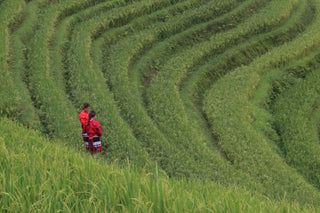
Rice cultivation is a cornerstone of global agriculture, feeding billions of people. However, it also has a complicated relationship with climate change. Traditional rice-growing practices, especially in continuously flooded paddies, are known to emit significant amounts of methane—a greenhouse gas far more potent than carbon dioxide. This often gives rice farming a negative carbon impact. However, the reality is more nuanced.
For example, the rice terraces in Longsheng, China, where we source our rice from are grown using sustainable practices which actually results in a carbon offset of emissions and enhanced soil health. Let's see how that works.
The Carbon Cost of Traditional Rice Cultivation
Conventional rice paddies are typically kept under flooded conditions, which create anaerobic (oxygen-deprived) environments in the soil. These conditions encourage the production of methane by soil microbes, resulting in emissions that often outweigh the benefits of any carbon sequestration by the rice plants themselves.
Methane is a greenhouse gas with a global warming potential up to 25 times greater than carbon dioxide over a century, making it a significant contributor to climate change. This means that, despite being a vital crop, traditional rice farming often leaves a negative environmental footprint.


How Sustainable Practices Reduce the Impact
Our partnering farmers cooperative in Longsheng take a different approach to rice cultivation, emphasizing sustainability and harmony with the environment. Here’s how:
1. Natural Water Flow
Our terraces are irrigated by a continuous flow of mountain water that cascades through the fields before returning to the river. Unlike stagnant, waterlogged paddies, this flow helps oxygenate the soil, reducing the anaerobic conditions that lead to methane production. While not eliminating emissions entirely, this method lowers their intensity.
2. Organic Farming Practices
We avoid synthetic fertilizers and pesticides, instead relying on natural methods to enrich the soil and manage pests. This reduces the environmental burden associated with chemical inputs and helps maintain the health of our local ecosystem.
3. Crop Rotation and Cover Crops
After the rice season, we plant cover crops to improve soil structure, prevent erosion, and restore nutrients. These crops, such as legumes and grasses, also add organic matter to the soil, which enhances its ability to retain carbon. Over time, these practices create a healthier, more sustainable soil ecosystem.


Carbon Offset: A Positive Side Effect
While rice terraces are not traditionally seen as a carbon offset contributors, our sustainable practices do offer some benefits:
- Carbon Sequestration: Through cover cropping and natural soil enrichment, our terraces are estimated to sequester between 5 to 10 tons of CO₂ annually across our 10 acres. This is a modest but meaningful contribution given the typical challenges of rice farming.
- Reduced Methane Emissions. The natural water flow helps mitigate methane production compared to fully waterlogged paddies, further improving the environmental balance.

A Sustainable Path Forward
The rice terraces of Longsheng represent the potential of thoughtful, sustainable farming practices to reduce agriculture’s impact on the environment. By prioritizing soil health, organic methods, and natural water management, we are working to balance the scales between food production and climate action. While the carbon offset from our practices is modest, it is a reflection of the multidude of benefits friendly farming practices can have on the environment.
If you'd like to learn more about the practices of the local farmers rice cooperative, please get in touch with us!


